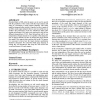Free Online Productivity Tools
i2Speak
i2Symbol
i2OCR
iTex2Img
iWeb2Print
iWeb2Shot
i2Type
iPdf2Split
iPdf2Merge
i2Bopomofo
i2Arabic
i2Style
i2Image
i2PDF
iLatex2Rtf
Sci2ools
SIGIR
2006
ACM
2006
ACM
Strict and vague interpretation of XML-retrieval queries
Structural hints in XML-retrieval queries can be used to specify both the granularity of the search result (the target element) and where in a document to search (support elements). These hints might be interpreted either strictly or vaguely, but does it matter if an XML search engine interprets these in one way and the user in another? The performance of all runs submitted to INEX 2005 content and structure (CAS) tasks were measured for each of four different interpretations of CAS. Runs that perform well for one interpretation of target elements do so regardless of the interpretation of support elements; but how to interpret the target element does matter. This suggests that to perform well on all CAS queries it is necessary to know how the target structure specification should be interpreted. We extend the NEXI query language to include this, and hypothesize that using this will increase the overall performance of search engines. Categories and Subject Descriptors H.3 [Information ...
| Added | 14 Jun 2010 |
| Updated | 14 Jun 2010 |
| Type | Conference |
| Year | 2006 |
| Where | SIGIR |
| Authors | Andrew Trotman, Mounia Lalmas |
Comments (0)

